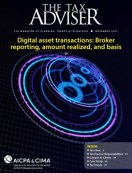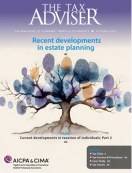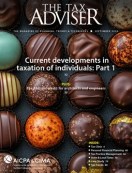- column
- TAX PRACTICE & PROCEDURES
SSTS 1.4: A practical discussion of software reliance
Related
Government withdraws defense of retirement fiduciary rule
Practitioner engagement letters: Strategies for increasing compliance
Preparer’s intent to evade tax extends taxpayer’s limitation period
Editor: Arthur Auerbach, CPA, CGMA
It is unfathomable to think of preparing a tax return without relying on software; likewise, tax consulting, estimates, and research begin with software or artificial intelligence (AI). The use of such tools is becoming more prevalent as technological advances are made and the law becomes more complex and volatile.
The AICPA’s Statements on Standards for Tax Services (SSTSs) are the Association’s enforceable tax practice standards, applicable to all AICPA members providing tax services. Revisions to the SSTSs effective Jan. 1, 2024, include new SSTS Section 1.4, Reliance on Tools, which was designed to protect members’ use of software and other tools by specifically allowing some reliance on tools and helping to define reasonable use. Under the standard, a member may reasonably rely on tools used in providing tax services to a taxpayer, exercising appropriate professional judgment and professional care (SSTS ¶¶1.4.3 and 1.4.4).
However, members should be cautious of overreliance on such tools when providing tax services. Tools are not a substitute for professional judgment or knowledge, and members must take reasonable steps to determine that the tools used are appropriate for their intended purpose (SSTS ¶1.4.7).
Members practicing in smaller firms or as solo practitioners may not have the resources to develop or extensively evaluate each feature or calculation of a tool prior to or during use. This column proposes reasonable considerations that a member can contemplate in determining the appropriate level of reliance on a tool.
Questions and concerns members should raise when selecting a tool include:
Consider the source of the tool: Subscription–based software by well–known and well–reviewed companies should be favored over software developed by an unknown source. Software development requires extensive research, time, and monetary resources, and developers usually expect to benefit from such an investment through sales. The developer must also invest resources in continued support. While stand–alone tools without a subscription may be sufficient for many uses, it is important to consider the developer’s ability to create the tools without continued compensation in the form of a subscription. If the developer is not compensated for continued use and development, the tax professional may need to perform a more extensive review of the tools’ output.
What is the update process and timeline for the software? Tools developed but never updated for tax law changes or additional interpretations of data cannot be relied upon past the initial window of development, if at all. Updates must be developed timely and frequently to be reliable. Practitioners must implement all updates upon release and should have a schedule to check for updates that may have been missed. Members must also stay aware of updates that will not be developed in time, such as changes to tax preparation software for retroactive changes to tax laws.
Does the work product appear to be reasonable? A professional cannot rely on a tool alone to create accurate work; the member should review the work product for accuracy and reasonableness. If the practitioner discovers frequent errors in a tool, the tool should be reevaluated for continued use or replacement.
Is the tool appropriate for the work being performed? The member must evaluate not only whether the potential tool is reliable but also whether it is suitable for the task at hand. This includes evaluating the robustness of the software to perform calculations in comparison to the complexity of the situation.
Can the member evaluate the proposed tool for flaws or other failure points and accommodate any such flaws without compromising the work product? Software may have errors or set limitations, such as limited types of forms available or the inability to consider certain data. The member must identify such flaws, either through review or through accessing others’ stated experiences and reviews, and override or use alternate tools as required to meet professional standards.
Can the use be tailored to the limits of the tool? Some tools may be appropriate for certain uses and inappropriate for a greater scope. In this scenario, it may be appropriate to rely on the tool as a starting point, such as beginning with a general search using AI, then continuing to expound upon the research before relying on the outcome. The member should study the source data, using the information to assist in formulating a position that is supported by continued research.
Can the data source be validated? The member must consider what is being accessed when using AI. Is the input data from a closed–loop source, or is the software able to access other data points, either within the company or without, potentially introducing unanticipated data? Many software suites may interact and share data between the programs and can pull in data not contemplated for a specific project. For instance, estimate calculation software may pull income information from tax preparation software and may include data from the prior year that will not be present in the current year or may not include data from an override, all without the practitioner being aware. Additionally, data accessed for research can be limited to Internal Revenue Code sections or other legitimate sources using some tools or may be unlimited in other tools and able to access sources such as opinion pieces or proposed legislation, distorting the results.
Is it contained software or is there generative AI? Generative AI will develop new content based on patterns learned from existing data. It develops novel output rather than providing source data. While generative AI can be useful, it can also create answers that are not rooted in actual research. The member must understand if it is possible to fabricate results if the appropriate data is not found. Tools that can return a “results not found” or “unknown” as a result are generally more appropriate for use. The member must still be able to distinguish between actual research and unsubstantiated creations.
Is the tool a net benefit to the member and/or the taxpayer? Tools utilized in providing services to taxpayers should increase efficiency and create an equivalent or better work product than what would be produced without the tool.
Does the tool meet other required standards of the professional? The member must take into account other standards, such as those imposed under the Gramm–Leach–Bliley Act, P.L. 106–102, or Treasury Circular 230, Regulations Governing Practice Before the Internal Revenue Service (31 C.F.R. Part 10), and consider whether the tool is robust enough and developed to the standards to meet those requirements. Does the tool meet the requirements of the written information security plan of the practitioner, as required for obtaining a preparer tax identification number (PTIN)? Any tool used by the practitioner must be secure and not potentially disclose confidential information to a third party.
Does the tool allow sufficient input for meeting professional–judgment standards? Members cannot tie themselves to the limitations of the software. Tools that require only certain input, such as questionnaire–style data–entry tools that prompt the tax professional to determine the correct form, may not request all information required to make the appropriate professional judgment. Members must limit their reliance on the output of such tools after taking into account the remaining data not requested by the tool. Similarly, if using the tool to gather data from the taxpayer, the member must consider if the tool requests the correct and sufficient data without additional questions from the professional. For instance, minimal input is required for software to complete the due–diligence checklist for tax credits, whereas professional obligations require more thorough questioning to determine if the facts meet the standards to claim the credits.
Is the tool suitable for the competency of the staff utilizing it? Tools used by a firm may require special training or skills not acquired by all members of the staff. A tool can be reasonably relied upon only if the user can competently operate it. To limit errors, the tool may need to have a bifurcation of permission levels for data accessed or for the ability to utilize certain features.
Is there a control mechanism? All tools are subject to failure. The member must have a control mechanism in place for any implemented tool. Consider the potential consequences of failure when determining the appropriate level of controls required. One such example would be that if a tool is utilized to automate signatures and e–filing, there should be a schedule in place to verify that all signature pages sent were subsequently received back and all e–files were accepted.
Appropriate skepticism and review
The starting point of most research today is a search engine. The starting point for preparing forms is software. Relying upon such tools is a necessary component of any modern practice, but members must employ professional skepticism in determining which information can be relied upon, the direction of research after starting, and the level of review required for the output of the tools. The use of tools does not supplant the professional’s responsibility; review is the final necessary step for all reliance on tools.
Contributors
Pamela Slatten, CPA, J.D., MBA, is an attorney and director with Marietta CPAs in Indianapolis, of which Larry Marietta, CPA, is the owner. Arthur Auerbach, CPA, CGMA, is an independent tax consultant in Atlanta. Auerbach is chair and Marietta is a member of the AICPA Tax Practice and Procedures Committee. Slatten is a member of the AICPA Tax Practice Management Committee. For more information about this column, contact thetaxadviser@aicpa.org.














